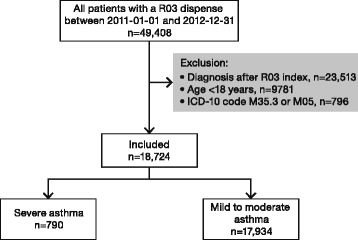Prevalence and management of severe asthma in primary care: an observational cohort study in Sweden (PACEHR)
- PMID: 29347939
- PMCID: PMC5774144
- DOI: 10.1186/s12931-018-0719-x
Prevalence and management of severe asthma in primary care: an observational cohort study in Sweden (PACEHR)
Abstract
Background: Severe and uncontrolled asthma is associated with increased risk of exacerbations and death. A substantial proportion of asthma patients have poor asthma control, and a concurrent COPD diagnosis often increases disease burden. The objective of the study was to describe the prevalence and managemant of severe asthma in a Swedish asthma popuöation.
Methods: In this observational cohort study, primary care medical records data (2006-2013) from 36 primary health care centers were linked to data from national mandatory Swedish health registries. The studied population (>18 years) had a record of drug collection for obstructive pulmonary disease (ATC code R03) during 2011-2012, and a physician diagnosed asthma (ICD-10 code J45-J46) prior to drug collection. Severe asthma was classified as collection of high dose inhaled steroid (> 800 budesonide or equivalent per day) and leukotriene receptor antagonist and/or long-acting beta-agonist. Poor asthma control was defined as either collection of ≥600 doses of short-acting beta-agonists, and/or ≥1 exacerbation(s) during the year post index date.
Results: A total of 18,724 asthma patients (mean 49 years, 62.8% women) were included, of whom 17,934 (95.8%) had mild to moderate and 790 (4.2%) had severe asthma. Exacerbations were more prevalent in severe asthma (2.59 [2.41-2.79], Relative Risk [95% confidence interval]; p < 0.001). Poor asthma control was observed for 28.2% of the patients with mild to moderate asthma and for more than half (53.6%) of the patients with severe asthma (<0.001). Prior to index, one in five severe asthma patients had had a contact with secondary care and one third with primary care. A concurrent COPD diagnosis increased disease burden.
Conclusion: Severe asthma was found in 4.2% of asthma patients in Sweden, more than half of them had poor asthma control, and most patients had no regular health care contacts.
Keywords: Asthma prevalence; Severe asthma; Uncontrolled asthma.
Conflict of interest statement
Ethics approval and consent to participate
The study protocol was approved by the regional ethics committee in Uppsala, Sweden (reference number 2014/446).
Consent for publication
Not applicable.
Competing interests
All authors have completed the ICMJE uniform disclosure form at
Publisher’s Note
Springer Nature remains neutral with regard to jurisdictional claims in published maps and institutional affiliations.
Figures


References
-
- Global Initiative for Asthma . Global strategy for asthma management and prevention. 2016.
Publication types
MeSH terms
Substances
LinkOut - more resources
Full Text Sources
Other Literature Sources
Medical
Research Materials

